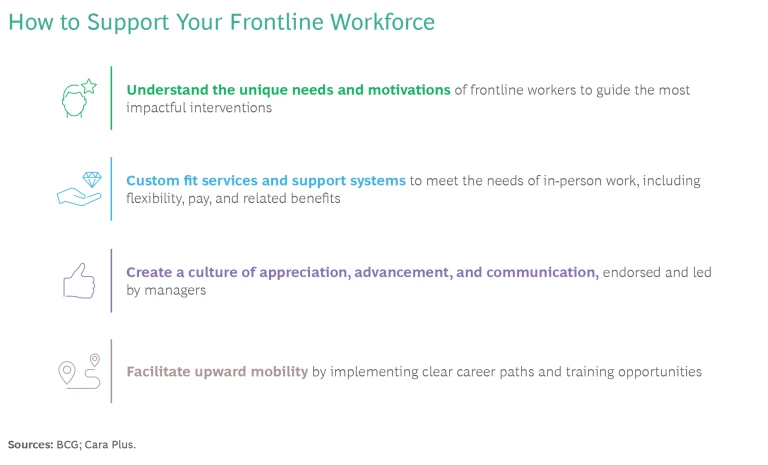This article was developed in collaboration with Cara Plus.
The 100 million frontline workers in the US play a critical role, forming the backbone of many of the largest US companies. But more than half of the people in this important demographic say they feel burned out, according to BCG research, and more than a quarter are either actively or passively looking for a new job—citing low pay, low morale, lack of flexibility, underappreciation, and limited advancement opportunities.
It doesn’t have to be this way. And it shouldn’t be.
With proper attention and investment, frontline workers constitute a motivated workforce that can unleash an organization’s highest potential, providing significant business value, reducing turnover costs, and serving as a pipeline for higher-level roles. (See the sidebar, “The Impact of Frontline Workers.”) The benefits for employers are significant: employees with higher satisfaction demonstrate a 17% increase in productivity, a 25% decrease in turnover, and a 41% decrease in absenteeism.
Moreover, rewarding jobs and career advancement opportunities offer upward economic mobility to frontline workers and their families—64% of whom are women, 40% of whom identify as nonwhite, and 23% of whom are members of low-income families, according to the US Equal Employment Opportunity Commission. This means employers can directly impact diversity, equity, and inclusion and generate ripple effects on state and local economies.
The Impact of Frontline Workers
…are employed across industries including customer service, financial and professional services, health care, hospitality, manufacturing, retail, shipping, logistics, and transportation.
…number approximately 100 million in the US, making up more than 70% of the workforce.
…are motivated employees. Frontline workers want to stay in their jobs and progress along a career trajectory. In fact, lack of career advancement opportunities is the second-leading motivator of attrition (41%) after lack of flexibility and work-life balance (50%), followed by insufficient pay (30%), lack of enjoyment of current role (15%), and lack of recognition for contributions (14%).
…become thoughtful managers. Frontline workers most value managers who offer clear and transparent communications, recognize good work, and provide support when help is needed—and they bring the same qualities as they grow into leaders.
To provide the optimal environment for frontline workers—and to capture benefits themselves—companies can rethink how they support and engage those workers.
In partnership with Cara Plus (a division of the workforce development organization Cara Collective), BCG spoke to employers across a variety of industries to understand how they designed and executed initiatives targeting their frontline workforce. Our analysis found that companies tackled the work on four fronts (see the exhibit).

Understanding Unique Needs and Motivations
Employers that take the time to understand what frontline workers care about, what an organization successfully delivers to such employees, and where it falls short are best able to meet the needs of their frontline workforce. In our research, we saw that when issues arose that affected frontline workers’ performance, a “curious, not furious” employer mindset helped uncover the root causes.
For example, Advocate Health Care, which operates in the Midwest, found that it was losing 75% of its frontline staff across some departments. Leaders were puzzled: Advocate offered a breadth of services and DEI programs to train leaders and make employees feel welcome and supported.
To uncover how employees were really feeling, Advocate launched a series of surveys within targeted departments, surfacing some less-visible barriers to retention, such as a lack of access to transportation and childcare. Before they received their first paychecks, new employees were often short on funds to cover these basic needs during their first few weeks on the job, so they were leaving because they had no easy way to get to work. Advocate realized it needed to take action and began to explore solutions.
When issues arose that affected frontline workers’ performance, a “curious, not furious” employer mindset helped uncover the root causes.
Likewise, Kroger, a leading grocery retail chain, acknowledged that its limited awareness of its frontline employees’ needs and preferences impacted both hiring and retention. How, the company wondered, could it identify and address specific pain points?
Observations from managers were informative for leadership, but the most powerful findings came directly from associate resource groups (ARGs), which were created as affinity groups for frontline associates. Consistently, ARGs requested more support for “well-being”—financial, physical, and emotional—even as different ARGs championed specific priorities (the Parents’ ARG, for example, pushed to expand family-support benefits). Equipped with this new understanding, Kroger was able to design more purpose-fit services for its associates.
Custom-Fitting Services and Supports
Find creative solutions to flexibility challenges. While employees in many roles across the US welcomed the flexibility of remote work during and after the pandemic, this was not an option for most frontline workers. Their largely onsite job requirements created a conundrum for employers, which needed to adjust their employee value propositions in response. Our conversations with company leaders revealed that flexibility—and the ability to have predictability and control over their schedules—was not only a high priority for frontline workers but also a factor that enabled them to stay on the job.
For instance, a large retailer headquartered in the western US had struggled to staff its warehouses, given the tight labor market and high turnover. Rather than staying on the hiring and replacement treadmill, the retailer sought to improve retention, with an explicit focus on addressing its associates’ request for flexible work schedules. Instead of assigning shifts, warehouse managers invited frontline workers to choose four-hour shifts compatible with their personal schedules. The shorter scheduling blocks were easier to swap or cancel and reduced no-shows. Giving frontline employees more agency over their schedules led to increases in hiring and retention—especially among women and parents.
Reassess pay and benefits. Because many frontline roles are low wage, it’s not uncommon for frontline workers to live paycheck to paycheck. Receiving competitive wages—or needed support when higher pay isn’t possible—helps decrease turnover.
After receiving feedback from its frontline associates, Kroger decided to focus its well-being strategy on financial support. To achieve this, the company invested in competitive hourly starting wages for its frontline talent, with the HR and finance departments working together to benchmark pay and benefits, including 401K contributions, leave-of-absence policies, and transportation support.
Kroger also brought on Goldman Sachs Ayco, a provider of financial planning benefits, to extend a financial coaching program to frontline workers and began communicating the offerings during training and onboarding sessions, to good early uptake.
Like Kroger, Advocate Health Care channeled its energy toward expanding benefits that resonated with its frontline workforce. As a pilot program, the company brought in coaches to liaise directly with workers in select departments and cocreate solutions to the basic-needs challenges identified in employee surveys. For example, to address transportation accessibility, Advocate began to offer gas cards and bus and rail passes; for employees with food insecurity, it supplied cafeteria and grocery vouchers. Today, 86% of frontline workers in Advocate’s Teammate Success Coaching Program have used a support service, and six-month retention among those who completed the program increased to 95%—a dramatic improvement.
Creating an Inclusive, Communicative Culture
Tap the power of direct managers. Despite companies’ redoubled efforts to improve workplace culture since the pandemic, frontline workers have continued to report low feelings of belonging. Nonetheless, we found glimmers of hope in a key but often overlooked stakeholder: the frontline supervisor. Feelings of belonging improved when frontline managers played a hands-on role in creating a positive workplace culture, offering what employees valued most: clear and transparent communication, recognition of good work, and generous support when help was needed. The reverse was also true: managers who did not thoughtfully communicate or support staff actively eroded culture. (See the sidebar “Managers Matter.”)
Managers Matter
Frontline workers who advance in their careers are:
- 23% more likely than peers to have had frequent manager-led career discussions
- 15% more likely to have received positive feedback from their managers
- 50% more likely than peers to feel burned out
- Three times more likely not to recommend their employer as a place to work
- Twice as likely to leave
Walmart’s longstanding culture of promoting from within and focusing on frontline advancement ensures that managers understand the needs of frontline workers because many are former frontline workers themselves. Leadership invested heavily in developing its frontline associates to prepare them to be future supervisors—an effort that has paid off. Seventy-five percent of Walmart’s salaried managers began as entry-level frontline workers for the retailer, and 88% of roles above entry level were filled internally in fiscal year 2023, creating advancement opportunities for junior staff and a talent pipeline for managers. As one director at Walmart reported, the emphasis on frontline experience among the leadership team “helped prioritize the needs of associates” and bring their perspectives to the forefront.
Advocate Health Care also saw the importance of involving managers in establishing an inclusive culture. When frontline managers were informed of the program’s aim from the beginning and positioned to codevelop the details, the initiative excelled: managers could address questions about whether it was better to have frontline employees train in the morning or the afternoon, for example, or how to release new employees from duties for a meeting with their coach. As a result, the proposed actions were much more quickly adopted.
BCG research has shown that changes tend to “stick” when those who are directly impacted are closely involved in planning and implementation. Thus, treating frontline workers and managers as thought partners and change enablers can boost their buy-in and improve the chances that the initiative will succeed.
Communicate, communicate, communicate. While reaching desk-based workers is relatively easy—because they are often logged in to their computers and checking email or online messaging systems—engaging frontline workers can be more difficult, especially if their roles don’t require them to be online all day.
To address communications gaps, Kroger devised a multimodal strategy, providing managers with talking points to deliver face-to-face while simultaneously circulating the messages through in-store tablets that frontline workers used regularly. Kroger also normalized usage of a customized mobile phone app, originally used for learning and development, as a primary means of communication, pushing out important organization-wide notifications and celebrating milestones like work anniversaries. The app also provided another feature that was critical for its frontline workforce: translation services, which gave non-native-English speakers the ability to access key communications.
Advocate Health Care’s coaches proved to be another avenue for transparent communication. The company told us that it was surprised by how quickly frontline workers opened up to their coaches—trust was almost immediate. The issues that were shared were not new, but having a safe space to talk about them was. Not surprisingly, employees were not comfortable sharing certain issues (if a worker had been struggling to find stable housing, for example) with their boss but felt they could be more honest and transparent with someone in an ombudsman role, especially one using open and judgment-free prompts like “What brings you here?”
Facilitating Upward Mobility
Create learning and development opportunities. In a 2022 BCG survey of frontline workers, 41% of respondents cited lack of career advancement opportunities as the reason for wanting to leave their jobs. That made it the second biggest complaint, behind lack of flexibility.
Kroger, like many other employers, acknowledged that frontline workers were motivated to progress in their careers—but the company also acknowledged that its decentralized approach to training left it without a simple and consistent way to upskill associates. In response, Kroger partnered with Axonify, a specialist in AI-powered learning for frontline workers, to launch Fresh Start, a tailored learning and development program, which provided purposeful, bite-size lessons related to an associate’s role and next steps for their career path, personalized to each associate’s pace and level. It also had a library of resources that allowed for individualized learning and progression—all through just three to five minutes of learning per day.
The University of Chicago took a different approach, building a new set of pathways for frontline workers through apprenticeships and internships that laddered up to full-time employment. Modeled on best practices, the program allowed frontline apprentices to “learn and earn”—to gain credentials while working. Academic partnerships with City Colleges of Chicago were intentionally crafted to accommodate workers’ job and classroom schedules. And cohort-based training helped apprentices feel less on their own in navigating logistics, institutional culture, and job progression.
Prove program value—and continue innovating. BCG research has highlighted the importance of measuring the effectiveness of learning and development programs, including programs that establish frontline skills. And the companies we studied agreed: tracking the impact of new efforts helped take what worked to a wider audience—or it revealed that a program didn’t work out as planned.
When the University of Chicago launched its youth internship program, it assigned participants to administrative roles or placed them on random tracks, assuming that the opportunity to experience what it’s like to work in an office would be sufficient. But surveys and feedback that participants shared with their mentors revealed that youths in the program had developed clear interests and wanted to pursue particular fields. They felt that a program to match the opportunities at the university with their interests would make the program more valuable—and the university successfully adapted it.
At Kroger, Fresh Start began as a pilot at a large store with supportive management. To test if it had wider potential, the company’s vice president of total rewards and HR systems monitored the program and worked collaboratively with senior finance and talent leaders to examine the impact on key performance indicators, such as the customer return rate, sales, and staff friendliness. Deemed a success on those measures, Fresh Start was scaled companywide. It was also a success in terms of adoption: 80% to 85% of Kroger associates engage with Fresh Start regularly and turnover has decreased.
Said Kroger’s senior director of HR, “We understood that Fresh Start would be a big undertaking, but we were able to show senior executives that it would be a good investment too. Now, the program has proven its positive impact on our workers and our business.”
Companies can successfully address the needs and potential of frontline workers in myriad ways. These efforts deliver dividends as well: they often end up benefiting employees beyond the frontline worker population, and they create a more motivated, productive workforce that is less likely to leave and more likely to advance to management or leadership roles.
That’s an encouraging return on investment. And it shows that the frontline and the bottom line are inextricably linked.
The authors thank the following BCG and Cara Collective colleagues for their contributions to this article: Aine Keel, Alex Damiano, Ben Ruxin, Chenault Taylor, Hannah Paul, Hope Allen, Kate Myhre, Mariya Bokvun, Mark Toriski, Nico Lake, and Rohan Angadi. In addition, Cara Plus wishes to thank the Stand Together Foundation and Walmart for the funding support that made Cara’s contributions possible.




